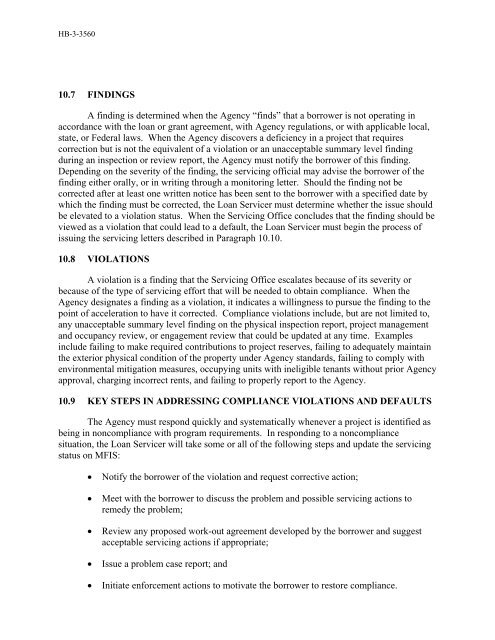CHAPTER 10: COMPLIANCE VIOLATIONS, DEFAULTS, AND ...
CHAPTER 10: COMPLIANCE VIOLATIONS, DEFAULTS, AND ...
CHAPTER 10: COMPLIANCE VIOLATIONS, DEFAULTS, AND ...
You also want an ePaper? Increase the reach of your titles
YUMPU automatically turns print PDFs into web optimized ePapers that Google loves.
HB-3-3560<br />
<strong>10</strong>.7 FINDINGS<br />
A finding is determined when the Agency “finds” that a borrower is not operating in<br />
accordance with the loan or grant agreement, with Agency regulations, or with applicable local,<br />
state, or Federal laws. When the Agency discovers a deficiency in a project that requires<br />
correction but is not the equivalent of a violation or an unacceptable summary level finding<br />
during an inspection or review report, the Agency must notify the borrower of this finding.<br />
Depending on the severity of the finding, the servicing official may advise the borrower of the<br />
finding either orally, or in writing through a monitoring letter. Should the finding not be<br />
corrected after at least one written notice has been sent to the borrower with a specified date by<br />
which the finding must be corrected, the Loan Servicer must determine whether the issue should<br />
be elevated to a violation status. When the Servicing Office concludes that the finding should be<br />
viewed as a violation that could lead to a default, the Loan Servicer must begin the process of<br />
issuing the servicing letters described in Paragraph <strong>10</strong>.<strong>10</strong>.<br />
<strong>10</strong>.8 <strong>VIOLATIONS</strong><br />
A violation is a finding that the Servicing Office escalates because of its severity or<br />
because of the type of servicing effort that will be needed to obtain compliance. When the<br />
Agency designates a finding as a violation, it indicates a willingness to pursue the finding to the<br />
point of acceleration to have it corrected. Compliance violations include, but are not limited to,<br />
any unacceptable summary level finding on the physical inspection report, project management<br />
and occupancy review, or engagement review that could be updated at any time. Examples<br />
include failing to make required contributions to project reserves, failing to adequately maintain<br />
the exterior physical condition of the property under Agency standards, failing to comply with<br />
environmental mitigation measures, occupying units with ineligible tenants without prior Agency<br />
approval, charging incorrect rents, and failing to properly report to the Agency.<br />
<strong>10</strong>.9 KEY STEPS IN ADDRESSING <strong>COMPLIANCE</strong> <strong>VIOLATIONS</strong> <strong>AND</strong> <strong>DEFAULTS</strong><br />
The Agency must respond quickly and systematically whenever a project is identified as<br />
being in noncompliance with program requirements. In responding to a noncompliance<br />
situation, the Loan Servicer will take some or all of the following steps and update the servicing<br />
status on MFIS:<br />
• Notify the borrower of the violation and request corrective action;<br />
• Meet with the borrower to discuss the problem and possible servicing actions to<br />
remedy the problem;<br />
• Review any proposed work-out agreement developed by the borrower and suggest<br />
acceptable servicing actions if appropriate;<br />
• Issue a problem case report; and<br />
• Initiate enforcement actions to motivate the borrower to restore compliance.
















